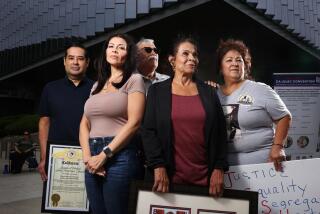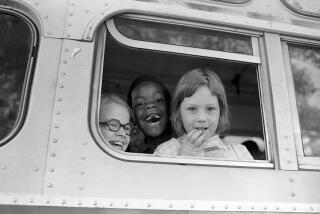New lessons at a historic school
Topeka, Kan. — The school at the center of a landmark U.S. Supreme Court desegregation ruling is scheduled to reopen its doors as a museum Monday on the 50th anniversary of the historic decision.
Plans to transform Monroe Elementary School into the Brown v. Board of Education National Historic Site began in 1992, said spokeswoman LaTonya Miller. The facility, which is managed by the National Park Service, was designed to give 21st century visitors a feeling of life during the days of overt racial discrimination.
Once inside, visitors immediately face a choice: Walk through an entryway marked “white” or one marked “colored.” In one gallery, they will pass through a video gantlet of historical footage showing the angry faces of white opponents of desegregation.
The opening events are scheduled to start at 11 a.m. Monday. As of the Travel section’s deadline Tuesday, President Bush was scheduled to attend, so security was expected to be tight.
Linda Brown and other African American children were forced to attend Monroe even though it was farther from their homes than all-white schools. The Browns became one of 13 families to challenge Topeka’s segregated schools in a 1951 lawsuit filed by the National Assn. for the Advancement of Colored People. The Supreme Court combined the Kansas case with four cases from other states. Its unanimous ruling, delivered May 17, 1954, upheld the 14th Amendment to the U.S. Constitution and, in effect, reversed the court’s 1896 “separate but equal” decision in Plessy vs. Ferguson. Many historians credit the decision with launching the modern-day civil rights movement.
Visits begin in the school’s auditorium, where video screens around the room’s perimeter show how segregated schools came to be.
Historical photos are interspersed throughout the museum with timelines, interactive exhibits and audio-visual programs that tell the story of the court case and its impact on America. One interactive exhibit shows which states once required segregation of textbooks, hotels, pay phones and water fountains. Another gallery allows visitors to record their thoughts on paper and computers and with magnetic words.
The museum at 1515 S.E. Monroe St. will be open 9 a.m. to 5 p.m. daily. Admission is free. (785) 354-4273 or www.nps.gov/brvb.
More to Read
Sign up for The Wild
We’ll help you find the best places to hike, bike and run, as well as the perfect silent spots for meditation and yoga.
You may occasionally receive promotional content from the Los Angeles Times.






